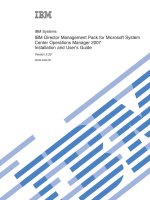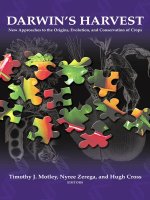The nexstar evolution and skyportal user’s guide
Bạn đang xem bản rút gọn của tài liệu. Xem và tải ngay bản đầy đủ của tài liệu tại đây (11.21 MB, 232 trang )
James L. Chen
The NexStar
Evolution and
SkyPortal
User’s Guide
Graphics by Adam Chen
The Patrick Moore
The Patrick Moore Practical Astronomy Series
More information about this series at />
The NexStar
Evolution and
SkyPortal
User’s Guide
James L. Chen
Adam Chen
James L. Chen
Shenandoah Astronomical Society
Gore, VA, USA
Adam Chen
Baltimore, MD, USA
ISSN 1431-9756
ISSN 2197-6562 (electronic)
The Patrick Moore Practical Astronomy Series
ISBN 978-3-319-32538-5
ISBN 978-3-319-32539-2 (eBook)
DOI 10.1007/978-3-319-32539-2
Library of Congress Control Number: 2016936674
© Springer International Publishing Switzerland 2016
This work is subject to copyright. All rights are reserved by the Publisher, whether the whole or part of
the material is concerned, specifically the rights of translation, reprinting, reuse of illustrations, recitation,
broadcasting, reproduction on microfilms or in any other physical way, and transmission or information
storage and retrieval, electronic adaptation, computer software, or by similar or dissimilar methodology
now known or hereafter developed.
The use of general descriptive names, registered names, trademarks, service marks, etc. in this publication
does not imply, even in the absence of a specific statement, that such names are exempt from the relevant
protective laws and regulations and therefore free for general use.
The publisher, the authors and the editors are safe to assume that the advice and information in this book
are believed to be true and accurate at the date of publication. Neither the publisher nor the authors or the
editors give a warranty, express or implied, with respect to the material contained herein or for any errors
or omissions that may have been made.
Cover design by Adam Chen.
Printed on acid-free paper
This Springer imprint is published by Springer Nature
The registered company is Springer International Publishing AG Switzerland
This book is dedicated to my friends
Helen and Steve,
and to Cheryl and Ray,
for their friendship and support over the years.
Other Books by
James L. Chen
How to Find the Apollo Landing Sites
(The Patrick Moore’s Practical Astronomy Series)
A Guide to Hubble Space Telescope Objects: Their Selection, Location, and
Significance
(The Patrick Moore’s Practical Astronomy Series)
The Vixen Star Book User’s Guide
(The Patrick Moore’s Practical Astronomy Series)
vii
Preface
It is very likely that every amateur astronomer has owned a Celestron telescope at
one time or another. And I am no exception. My experiences with Celestron telescopes began at the same time as my passion for backyard astronomy was reborn.
The Washington, D.C., area in the early 1980s was well known for George
Washington Birthday sales. Every year, bargain hunters were treated to exceptional
deals on all forms of consumer products, such as clothing, furniture, televisions,
stereo electronics, and cameras. In 1987, a local Washington, D.C., camera store
consolidated all its surplus camera and telescope items into its main warehouse for
a true blowout George Washington’s birthday sale. This particular sale included
several Celestron telescopes that were unsold from the previous year’s Halley’s
Comet sales push. My best friend and I entered the warehouse store and went crazy,
with me leaving with two Celestron telescopes and an armful of eyepieces. My
prized acquisitions were an orange tube Celestron C-5 with equatorial wedge and
an orange tube C-90 Astro with fork mount and clock drive. The Celestron C-5
completely renewed my interest in astronomy. It also sparked a bad case of Gear
Acquisition Syndrome, or sometimes known as GAS. In the next decade, I found
myself building, buying, and selling many telescopes (including a self-built 10-in.
Dobsonian telescope that resulted in my first published article in the November
1989 of Astronomy magazine). Along the way, both orange tube Celestron telescopes were sold. To this day, I wish I had kept that orange C-5.
By the early 1990s, I found myself owning a Celestron Ultima 8. The Ultima 8
was the ultimate expression of a pre-computerized 8-in. Schmidt-Cassegrain telescope, with heavy fork tines and an accurate clock drive system with hand controller. It was heavy, and boy was it stable. It had wonderful optics and was a joy to use,
with the exception of having to move it in and out of the house. Alas, apochromatic
ix
x
Preface
refractor fever got a hold of me, and the Ultima 8 was sold to finance a Brandon
130-mm apochromat refractor (which I still own). Another Celestron that I wish I
had kept.
By the early 2000s, I had bought, traded, and bargained my way through several
telescopes, culminating in the ownership of a classic Questar 3-1/2 in.
Maksutov-Cassegrain, with a 1/10th wave quartz mirror. It was a wonderfully portable telescope system that accompanied me on a trip to Hawaii, the shores of the
Chesapeake Bay to view and photograph the Venus transit of 2004, and several star
parties. All was good with the Questar, except for the limitations of such a small
aperture. In a clear case of aperture fever, the Questar was traded in for my current
big eye telescope, a Celestron 11″ GPS. Eleven inches of aperture, GoTo and GPS
drive system, and a versatile 2-in. diagonal, this Celestron has kept me happy for a
decade. I don’t miss the Questar!
I was working at a vendor booth at the 2014 NorthEast Astronomy Forum, conveniently known as NEAF, and was present at Celestron’s product announcement
of the Celestron Evolution series of telescopes. At an exclusive Celestron reception,
Celestron introduced their new telescope line called the Celestron NexStar
Evolution and a new 11-in. Rowe-Ackermann Astrograph.
The Celestron NexStar Evolution represents the latest developments in the long
line of Schmidt-Cassegrain designs. The new Celestron Evolution line includes
6-in., 8-in., and 9.25-in. telescopes mounted on newly designed heavy duty singlearm fork mount with WiFi-based computer GOTO drive systems. Mechanically, the
Celestron NexStar Evolution newly designed single-arm design is far sturdier than
the older SE single-arm design and is steady enough for use in astrophotography.
Most notable is the introduction of a new GOTO computer control system. In the
past, all telescope users are familiar with GOTO telescopes, with the hand controller and control cable attached to the base, and the power cables needed to provide
power. This rat’s nest of cables is eliminated with the new Celestron Evolution
telescopes. The telescope base comes equipped with a built-in rechargeable battery.
No longer does the user have to lug a separate battery pack to power the telescope
or have a power cable cord getting in the way during a observing session.
Additionally, no longer is the telescope user encumbered with an archaic hand
controller and the required telephone-like coiled controller cable. The Celestron
NexStar Evolution utilizes a revolutionary WiFi interface with the user’s tablet or
smartphone to control the telescope. The user’s iPhone, iPad, or Android tablet or
phone is loaded with the SkyPortal application. The SkyPortal application is used
to control the Evolution telescope, while providing the useful astronomy
information.
The WiFi capability will save you if you have a pet dog like I do. I love my
Labrador retriever Kaiser. He’s a great dog, but sometimes he gets a little rambunctious and crazy. Not long ago, he got a hold of the Celestron NexStar+ hand control
and chewed it up. I found the hand control on the floor, and the connecting cable
had been chewed off by Kaiser. What was left of the cable and connectors were
found in the corner of the family room, in a pool of yuk. Unfortunately, the hand
control bore a slight resemblance to one of his chew toys! He had mistakenly taken
Preface
xi
the hand control off my computer desk and proceeded to do his dog thing. Hence,
I now place all my new hand controls in a glass cabinet for protection. My iPad,
with the SkyPortal app, is safe from Kaiser’s attacks.
Further NexStar Evolution refinements include tripods that now have gradations
imprinted on the extendable legs to aid in leveling the mount on an uneven surface.
Of course, a bubble level is built in on the tripod. There are even eyepiece spaces
provided in both the tripod and drive base.
With the introduction of the NexStar Evolution series, I realized that a new era
had dawned on amateur astronomy, and plans for this book took form. Within these
pages, the description and process of using the novel WiFi-based control system
provided by the NexStar Evolution and the SkyPortal applications are detailed.
Note all photos of SkyPortal in action are taken from the screens of either an Apple
iPad or an Apple iPhone 5C. The screens are identical with Android devices.
Clear Skies and Good Music,
James L. Chen
Acknowledgments
A big Thank You to the following people who made this book possible:
To Alan Hale for his invaluable help on the history of Celestron.
To Ed McDonough, Michelle Meskill, Kevin Kawai, Eric Kopit, Bryan Cogdell,
and the rest of the Celestron crew for all their technical and historical content
support.
To Gary and Sherry Hand of Hands-On-Optics, for providing technical support,
conceptual ideas, and encouragement.
To my wife Vickie for her encouragement, her support, and her proofreading and
critiquing skills.
To my son Adam for his graphics abilities and valuable photographic suggestions and contributions.
To my son Alex for serving as a soundboard for some of my ideas for the book,
and making valuable suggestions and contributions.
And as always,
To Nora Rawn of Springer, who gave a fledgling first-time author a chance, for
supporting my book concepts, and being a good audience for my jokes.
xiii
Contents
1
A Brief History of Computerized Telescope Mounts
for Amateurs............................................................................................
1
2
A Review of Celestron GoTo Computerized Telescopes ......................
Fork Mounted Celestron SCTs .................................................................
Celestron Compustar.............................................................................
Celestron Ultima 2000 ..........................................................................
Celestron NexStar GPS .........................................................................
Celestron NexStar SE ...........................................................................
Celestron CPC.......................................................................................
Celestron SLT .......................................................................................
Celestron LCM......................................................................................
SkyProdigy ............................................................................................
German Mounted Celestron SCTs ............................................................
Celestron/Vixen Super Polaris Mount with Sky Sensor .......................
Celestron CGE ......................................................................................
Celestron AS-GT (CG-5GT).................................................................
Celestron CGEM, CGEM DX ..............................................................
Celestron CGE Pro................................................................................
Celestron VX ........................................................................................
7
7
7
8
10
10
11
11
14
14
15
15
17
18
20
21
24
3
Introduction to the Celestron NexStar Evolution
and SkyPortal App ..................................................................................
Telescope Optics .......................................................................................
SkyPortal Application ...............................................................................
Upgrades to SkyPortal ..............................................................................
27
28
31
32
xv
xvi
4
Contents
Basic Operation of the Celestron NexStar Evolution
and SkyPortal App ..................................................................................
Evolution Physical Setup ..........................................................................
Smart Device and WiFi Setup ...................................................................
SkyPortal, Alignment Options and SkyAlign ...........................................
Optional Automatic Alignment Using StarSense Accessory....................
Basic GoTo Search Operations .................................................................
Searching from the Common Objects List................................................
Help ...........................................................................................................
35
35
36
37
40
42
42
73
5
Basic Operation of the Celestron NexStar Evolution
and NexStar+ Hand Control .................................................................. 75
Alignment ................................................................................................. 76
SkyAlign with the NexStar+ HC .............................................................. 78
NexStar+ Hand Control Settings .............................................................. 90
GoTo Searches .......................................................................................... 93
Utilities...................................................................................................... 101
6
Lessons Learned in Using the Celestron NexStar Evolution
and SkyPortal ..........................................................................................
Lessons Learned on Using the Celestron NexStar Evolution
with SkyPortal ...........................................................................................
Trouble Shooting the Evolution/SkyPortal System ..................................
Further Discussion on Cold Weather Operation .......................................
Cold Weather Considerations for the Backyard Astronomer....................
WiFi Environment .....................................................................................
NexStar+ Hand Control Reset ..................................................................
SkyPortal Searches....................................................................................
113
113
115
118
118
120
120
121
7
Introduction to the SkyPortal WiFi Module ........................................ 123
WiFi Access Using the SkyPortal WiFi Module ...................................... 123
Compatibility Information ........................................................................ 124
8
Advanced WiFi Tricks ............................................................................ 127
9
Accessories for the Celestron NexStar Evolution.................................
Observing Accessories ..............................................................................
Astrophotography and Astro-Imaging Accessories ..................................
Eyepieces ..................................................................................................
Combination Visual and Astrophotography Accessory ............................
Auto-Alignment ........................................................................................
129
129
138
146
152
154
Contents
xvii
10
Mounting Other Optical Tubes on the NexStar
Evolution Mounts .................................................................................... 157
Operating the NexStar Evolution Mount with Another OTA:
SkyPortal Versus NexStar+ HC ................................................................ 159
11
Maintenance and Care of the NexStar Evolution Mounts
and Electronics ........................................................................................
General Maintenance and Care .................................................................
A Discussion on Dealers, Service, Mail Order, and Warranty..................
SkyPortal Updates .....................................................................................
Transporting Advice .................................................................................
Optics Collimation ....................................................................................
161
161
163
163
163
164
Appendix A: Troubleshooting Checklist ....................................................... 165
Appendix B: Celestron Timeline.................................................................... 167
Appendix C: Celestron NexStar Evolution Schmidt-Cassegrain
Telescope Specifications .................................................................................. 169
Appendix D: Messier Catalog ........................................................................ 173
Appendix E: The Caldwell Catalog ............................................................... 179
Appendix F: Selected Non-Messier Catalog NGC Objects ......................... 183
Appendix G: The Herschel 400 ...................................................................... 191
Appendix H: Current Sky Portal WiFi Module Compatible
Celestron Mount Specifications ..................................................................... 207
Appendix I: Glossary ...................................................................................... 211
Bibliography .................................................................................................... 215
Index ................................................................................................................. 217
About the Authors
James L. Chen is a Retired Department of the Navy and Federal Aviation
Administration Radar and Surveillance Systems engineer. He is a Former Program
Manager for Advanced Navigation and Positioning Corporation, guest lecturer at
local Washington, D.C./Northern Virginia/Maryland astronomy clubs on amateur
astronomy topics of eyepiece design, optical filters, urban and suburban astronomy,
and lunar observing, author of an Astronomy Magazine article on Dobsonian telescope design in November 1989 issue, and a contributor to Astronomy Technology
Today magazine. His first book was published in June 2014 by Springer, entitled
How to Find the Apollo Landing Sites. Second book entitled A Guide to the Hubble
Space Telescope Objects is also available from Springer. Third book entitled The
Vixen Star Book User Guide is also available from Springer. He served as a parttime technical and sales consultant for two Washington, D.C., area telescope stores
for over 30 years.
Adam Chen is a Former Program Manager of media support for NASA
Headquarters in Washington, D.C., and creator and executive producer of major
NASA publications, including the book and web-book application documenting
the history of the Space Shuttle Program “Celebrating 30 Years of the Space
Shuttle Program.” He served as graphics designer for all three James L. Chen’s
books and currently works in marketing for Brown Advisory, an investment firm in
Baltimore, MD.
xix
Chapter 1
A Brief History
of Computerized
Telescope Mounts
for Amateurs
In the ultimate mating of two hobbies, computers and astronomy, computer
controlled telescopes have captured the backyard astronomer’s imagination and
pocketbook. Known collectively as GoTo telescopes, this advanced technology is
fascinating to watch in action as the mount proceeds to point the telescope from
object to object with precision, accompanied with the sounds of motors whirring
and gears meshing.
A GoTo telescope mount is quite simply a telescope system that is able to find
celestial objects in the night sky, and then track them. The GoTo mount can be set
up in an alt-azimuth or equatorial fashion, and after the proper alignment procedure, the finderscope is no longer needed for the rest of the evening. Some of the
newer GoTo telescopes have electronics and CCD cameras that will perform the
alignment procedure automatically.
These telescope mounts are wonderful pieces of technology. The GoTo technology allows for more efficient use of observing time by quickly finding objects in
the night sky. Built into the hand controller is a microprocessor, firmware, and
built-in memory catalog of the positions of thousands of stars, galaxies, nebulae,
open star clusters, globular clusters, planetary nebulae, our solar system planets,
and the Moon. Complex algorithms developed and refined over years with improvements in encoders and motor technology have made the GoTo telescope an accepted
and desirable telescope feature. Computer controlled telescopes can help it’s owner
to overcome the fear of looking ridiculous while others watch; no longer will the
telescope owner appear incompetent as he tries to find celestial wonders—now he
only looks ridiculous as he tries to remember how to set up his telescope!
© Springer International Publishing Switzerland 2016
J.L. Chen, The NexStar Evolution and SkyPortal User’s Guide,
The Patrick Moore Practical Astronomy Series,
DOI 10.1007/978-3-319-32539-2_1
1
2
1
A Brief History of Computerized Telescope Mounts for Amateurs
There is an ongoing debate within the amateur astronomy community on the
merits of computer guided and computer controlled telescopes. The hardcore conservative backyard astronomers argue that a beginner or novice individual is better
served learning the skies without electronic aids, as generations of stargazers have
done. There is merit to this argument. However, in these days of increasing light
pollution in urban and suburban neighborhoods, seeing landmark stars used for
“starhopping” to locate deep sky objects is becoming increasingly difficult and
frustrating to a backyard astronomer, particularly to the beginner or novice. Using
bright first magnitude stars for alignment, a computerized GoTo system eliminates
frustration and introduces fun into the hobby. The search time for a celestial object
is reduced from tens of minutes to mere seconds! With the electronics aiding the
observer in finding the deep sky objects, a suburban observer can then take advantage of modern filter technology in overcoming the light pollution in their area.
Cheers to the miracle of nebula filters, light pollution filters, and color filters!
Of course, in the worst of urban environments, even using a GoTo telescope and
mount can be challenging, especially if bright stars are impossible to see for alignment purposes or otherwise. For instance, in the the middle of brightly lit Las
Vegas, the only bright stars visible are Wayne Newton, Celine Dion, and a variety
of Elvis impersonators!
The era of computerized GoTo telescopes began in 1984. Computer controlled
telescopes took form during the same period as the development of personal computers. During the 1980s, the US telescope company Celestron formed a business
relationship with Vixen Company, Ltd of Japan. The American company featured
its home grown Schmidt-Cassegrain telescope, while importing the Japanese
refractors, eyepieces, and equatorial mounts from Vixen, and marketing them under
the Celestron brand. The Sky Sensor was an economical system consisting of a
GoTo computer control system with motors designed to attach onto their portable
German equatorial mount known as the Super Polaris. The landmark Sky Sensor
system was remarkable for its time. As the first consumer affordable GoTo system,
it had 472 nebulae, star clusters, and galaxies stored in its memory. This is small,
as compared to today’s GoTo systems that have 30,000, 40,000, or more deep sky
objects stored in their databases.
The reader is cautioned to understand that database claims are sometimes
inflated and not necessarily truthful. There are a number of multiple counts for a
single object. For instance, the Andromeda Galaxy counts as one object; M31 is an
additional object; NGC 224 as another object. Thus the same object is counted as
three separate objects in some manufacturer’s database claims.
The Sky Sensor was revolutionary in 1984. The Sky Sensor data base contained
all the Messier objects, NGC objects brighter than tenth magnitude, and 285 stars
brighter than 3.5 magnitude.
Installation of the Sky Sensor onto a Super Polaris mount required a little
mechanical dexterity, but could be handled by the end user. And if not, the local
dealers were experienced in installing the right ascension motor and electronics
card, declination motor and electronics card, gear shafts and pressure plates, and
clutch knobs. Plug in the Sky Sensor controller and power supply, and the system
was ready for use.
1
A Brief History of Computerized Telescope Mounts for Amateurs
3
Fig. 1.1 The Sky Sensor computer controller (Hands-on-Optics Used Equipment archives)
The keyboard, as seen in Fig. 1.1 was a bit archaic. Note the use of CR for carriage return instead of an Enter key! The art of human factors engineering had not
yet entered into the design of telescope control. The end user faced a bit of a learning curve in operating the Sky Sensor. The system was not as responsive, accurate,
nor as quick as today’s modern GoTo systems, but as a first generation device it
showed the way to the future.
Introduced in 1987, Celestron Compustar 8 was the first computer controlled
telescope offered for the consumer. The Compustar 8 was large, heavy, and difficult
to produce. The history of Celestron GoTo telescopes is detailed in the next
chapter.
In 1992, Meade Instruments introduced the LX200 series of fork mounted
Schmidt-Cassegrain telescopes (SCT). Early 8 and 10 in. models that were produced contained software bugs and were unreliable telescopes. Over time Meade
was able to refine the LX200 models to become a very capable platform, with the
product line extending to larger models, of 12 and 16 in. sizes, telescopes more at
home in a college or NASA observatory than in the backyard. In August 1996
Celestron countered with the Ultima 2000 series telescopes—but they delayed shipping until 1997 until the software bugs were worked out. The initial offering was
an 8 in. SCT Ultima 2000, which was a lightweight, rigid, and easy to use telescope
(Fig. 1.2).
4
1
A Brief History of Computerized Telescope Mounts for Amateurs
Fig. 1.2 The Vixen Sky Sensor 3 (Hands-on-Optics Used Equipment archives)
Meanwhile in the late 1990s, Vixen issued a revised version of their GoTo system, named the Sky Sensor 3. The Sky Sensor 3 featured an updated hand controller
and other hardware. The database was still the same size (Fig. 1.3).
By 2000, Vixen introduced another revision to their venerable Sky Sensor series,
now known as the Sky Sensor 2000. The SkySensor 2000 system was vastly refined
and improved over the previous Sky Sensor models. The SkySensor 2000 could be
retrofitted for use with the Vixen GP, GP-DX, GP-E, SP or SP-DX equatorial
mounts to provide highly accurate “Go To” pointing and tracking of celestial
objects in a vastly expanded data base that now included the planets, Moon, Sun,
and thousands of deep sky objects from Messier, NGC, IC, UGC, SAO, and GCVS
catalogs, for a total of 13,942 celestial objects.
The revised system simplified the initial setup and was easier to operate. The
slewing rate was improved up to 1200× that of Sidereal rate (5–3/4 deg. per second). The Sky Sensor 2000 incorporated the most accurate of the tracking control
systems for the time by including Periodic Error Correction (PEC) circuitry to
reduce the amplitude of worm gear periodic errors.
In the new millennia, major developments in GoTo telescope technology have
been introduced into the consumer market. Meade and Celestron have introduced
and refined their Autostar and Nexstar GoTo systems for fork mount and German
mount designs. Databases of these telescope computer systems have been expanded
to the 30,000–40,000 celestial objects range, including entire Messier, Caldwell,
NCG, and IC catalogs of deep sky objects. Databases now include extensive lists of
1
A Brief History of Computerized Telescope Mounts for Amateurs
5
Fig. 1.3 The Sky Sensor 2000 series (Hands-on-Optics Used Equipment archives)
double stars, variable stars, comets, asteroids, and even man-made objects. Pointing
precision and tracking accuracies have been greatly improved. The ease of setup
has been improved. Many other manufacturers have joined the GoTo mount revolution, with offerings from Losmandy, Orion, Astro-Physics, Takahashi, iOptron, and
many more. The computerized GoTo telescope mount has come of age.









